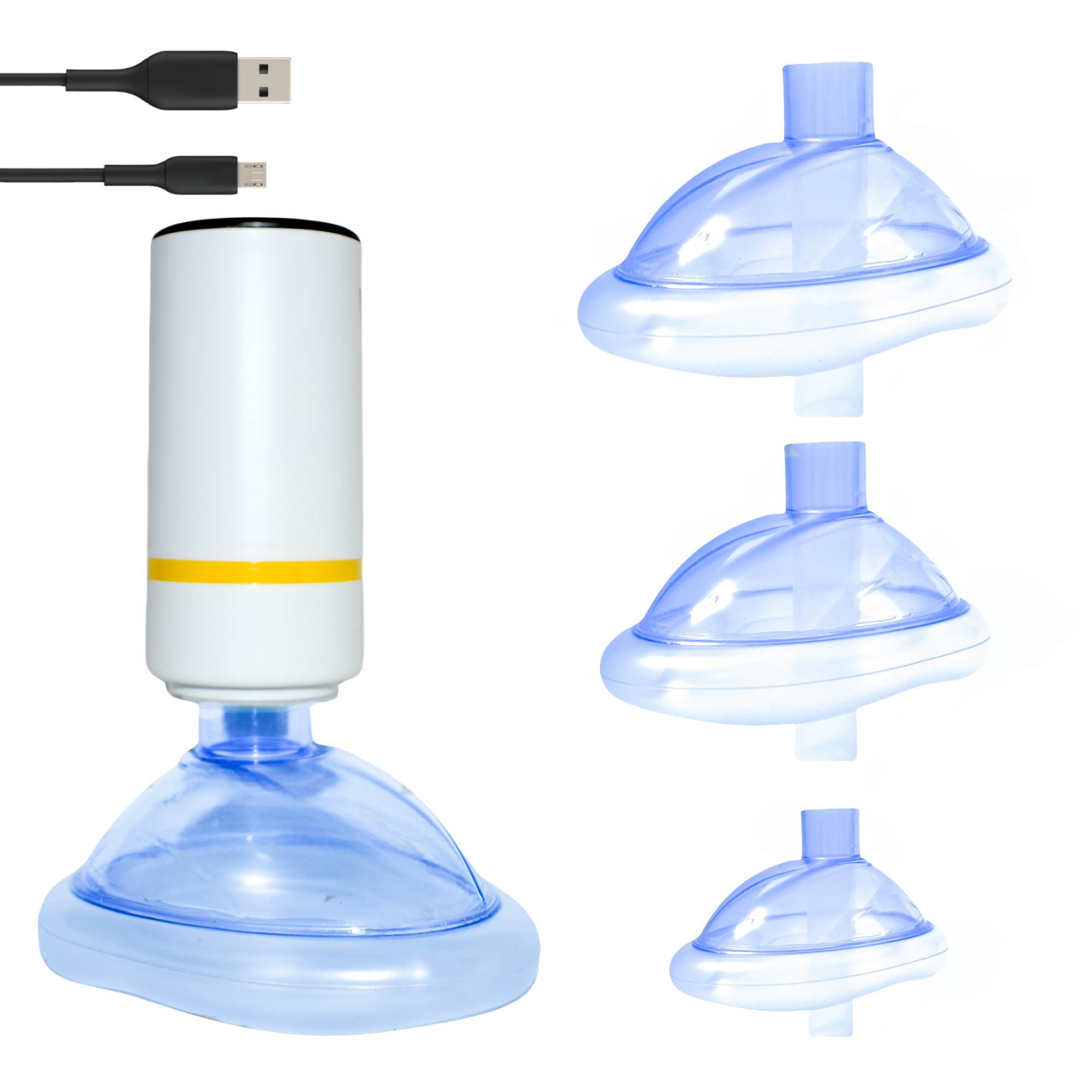What is an Anti-Choking Device and How Does it Work?
Delving deeper into how an Anti-Choking Device operates includes a keen understanding of its mechanics. Typically designed to restore normal breathing during choking, these devices particularly employ suction. In other words, a negative pressure is created, which makes for a strong sucking force that uses the object lodged in the throat to facilitate the flow of air into the lungs.
Offering a quick and effective means of clearing obstruction of the airway during choke emergencies are suction devices which are designed for use during choking episodes. Their efficacy depends on the amount of suction which is generated along with the proper technique used. Lives can potentially be saved and complications averted through these devices – as they provide an efficient and swift means to manage fatal choking incidents.
View anti-choking device for adult – Willnice details to get into the details.
While anti-choking devices can clear airway obstructions without any trouble, their effective deployment is heavily reliant on adequate training and proper guidelines, so it bears mentioning. Knowing the basic how to’s and the correct way of using the anti-choking device is critical to ensuring that the device remains effective throughout the duration of an emergency.
View anti-choking device for adult – Willnice for More Details
When Should You Use an Anti-Choking Device?
Identifying a Choking Incident
It is essential to pay attention to the signs of choking in order to offer the best help for someone who is in need. A person who is unable to speak, makes no noise and cannot breathe while holding his/her throat is likely to be choking. To avoid a more serious situation, one must intervene immediately.
Guidelines for Using an Anti-Choking Device during Emergencies
An anti-choking device can undoubtedly be a life saver during a choking emergency. Let us consider the general principles of using an anti-chocking device.
- Estimate the Degree of Impairment: Choking could range from a mild disorder up to a complete obstruction or strangulation of the air ways. In case the person choked is unable to cough, brunette in, or speak, be sure to act at once.
- Seek Assistance: Either call the emergency line or request someone in the vicinity to make the call while you attend to the individual experiencing the choking episode.
- Observe Precautionary Measures: Make sure to follow the proper directions given by the student’s instructor or books regarding the use of the anti chokers. Respond to the device’s recommended positioning as well as its application.
- Keep Composure and Indulge in Effective Communication: Rather than appearing anxious, do tell the choked party to stay calm and that help is coming. This could handle overwhelming feeling which is otherwise normal in such incidents.
- Take Additional Steps: Use the anti choking device in the stipulated manner and follow proper emboweling techniques to remove the obstruction to the airway passage. However, do not apply too much pressure which could lead to injury.
What to Do If Current Choking Protocols Have Been Followed
If the previously mentioned attempts to use an anti choking device or the existing choking protocols do not resolve the choking case, then the following steps are to be taken.
- Seek more assistance: If the airway remains obstructed and the person is still not able to breathe, dial emergency numbers immediately or enlist the help of a bystander to do so.
- Give CPR: In great cases when all efforts fail and the individual’s response goes mute, Then one must instantly attempt to start CPR, follow the instructions and measures suggested by the authorities or relevant professional medical staff.
It is crucial to remember that on one side, anti-choking devices perform to remove airway obstruction, but we also have to take into consideration that all the measures in an emergency case, the correct training, and the guidelines are necessary and have to be maintained. Furthermore, anti-choking devices can be ineffective when operating on patients who are suffering from loss of consciousness, and even after the established protocols are applied and an anti-choking device is used, a medical professional would be important.
What are the Benefits of Using an Anti-Choking Device?
Advantages of Suction-Based Airway Clearance Devices
Devices that utilize suction to clear airways, such as anti-choking aids, have several key strengths that make them useful in the management of choking episodes. As technology advances, these devices specifically function to rapidly remove airway blockage and allow for normal respiration. Here are the key benefits of incorporating an anti-choking device into your home kit:
- Timely and Effective Airway Clearance: Anti-choking devices are similar to suction pc a vacuum as they use suction to demolish obstructions lodged in the airways. This prevents enhancement in airway complications.
- Safe and Non-Invasive: Unlike other methods, such as back blows or abdominal thrusts, anti-choking devices use a suction-based approach to relieve airway blockages. The patient has active blockages during active distress and therefore pose a considerable safety concern and risk of further harming the individual suffocating.
- Suitable for Individuals of All Ages: With a good anti-choking device, there is no more concern about children or toddlers choking while eating food. कहीं भी अकेले दवाई लेने का कोई चिंता निःशुल्क, anti-choking devices are universally suitable devices to account for babies and infants including toddlers and adults.
- Convenient and Portable: Anti-choking devices are designed for ease of use, which means that they are easy to operate even for those who do not have extensive medical knowledge. Furthermore, these devices are convenient to carry and store, allowing for quick access during times of need, whether at home or traveling.
Through pushing the anti-choking device you can handle the life treating situations at the choking emergencies. Keeping this device along, you will be able to get pieces of eight more efficiently and at a very close distance to the loved ones that you want to save.
How to Properly Use an Anti-Choking Device?
Step-by-Step Guide on Using the Anti-Choking Device
- Evaluate the Condition: First, check if the individual has a partially or completely blocked mouth or nose. Signs of protrusion include signs of struggle to breathe, trying to speak without words coming out, and hiccupping.
- Let Someone Help: For holdup of the revised statement, Tell someone to call for help when the individual stops coughing, is unable to speak,k and is not breathing. Time is extremely important as this is a case of choking is an emergency.
- Get in A Supportive Position: Stand behind the individual a little towards one side in a supportive manner, where one of your hand is placed on their chin and the other hand is placed on their chest.
- Use Upwards Blows: You should be able to do this with relative ease; do so by using the heel of your palm so that firm back upward blows are applied alternately between each of the shoulder blades. To a maximum of five back blows, see if the object is dislodged after each blow.
- Use Abdominal Thrusts: Get yourself at the back of the person. Put one hand into a fist and with the other hand make a grasp on top of it. The hand which has supplied the grasp must then place its thumb side against the middle of the stomach, starting slightly above the navel and into the center. Thrusts from your grasp should be targeted upwards into your abdomen. Up until five of the motions above are acceptable, check the position after each of them has been executed.
Keep Performing CPR If Required: In any case, if the patient becomes unresponsive or starts to breathe, perform CPR in accordance with the instructions provided by the emergency dispatcher until assistance arrives.
Common Mistakes When Using an Anti-Choking Device
- Insufficient Force: Providing adequate force in abdominal thrusts and back blows is critical. Applying less-than-expected force may not effectively remove the lodged object in the vetoed airway.
- Improper Hand Placement: During abdominal thrusts, if the hands are not placed properly, they would also be less effective. Place the fist adequately above the navel to allow shifting of the diaphragm.
- Neglecting to Call for Help: Even if the obstruction has been successfully dislodged, one must not forget to seek assistance through emergency services for a thorough examination and medical treatment.
- Using an Ineffective Anti-Choking Device: Not every anti-choking thorough device is automatic; that is why the device to be issued should be tried and tested by the FDA and manufactured according to instructions set for it well.
When to Seek Additional Help After Using an Anti-Choking Device
In the following circumstances, not returning to a medical facility after employing an anti-chocking apparatus is not advisable.
When the person has extreme difficulty in breathing or persists in complaining about any discomfort.
When the foreign object previously believed to have been removed is blocking their airway.
When the person displays signs of extreme trouble or if the person becomes unconscious.
First-aid and CPR training will always prove beneficial for anyone who is in a position of having to assist someone with a choking emergency. Knowledge and availability of such information always aids in safeguarding one’s own self or another individual.
What Should Be Included in Your Anti-Choking Home Kit?
Essential Items for Choking First Aid and Rescue
Having a warning containing a properly maintained first aid kit is key during choking emergencies. Here is a compilation of many needed anti-choking items:
Anti Choking Device: Get a good FDA approved device that directly addresses choking issues. Make sure there is one appropriate for children and another one appropriate for adult as per the manufacturer’s recommendations.
CPR face Mask: This device is used when CPR is being administered so the patients mouth is covered when blowing into them.
Latex Free Gloves: Latex free gloves are to be used when a person is infected with a specific infection to lower the chances of cross infection.
Scissors: If need be and clothing are wrapped too tightly around anyones neck then sharp scissors can be used to cut through the fabric.
Rescue Blankets: After a person goes through a choking episode covering them with a lightweight and compact rescue blanket to make them feel warm and comfortable is ideal.
Emergency Contact Information: Phone numbers and contacts to professional aid are to be included.
The Importance of Having a Travel Kit for Choking Emergencies
Having a portable kit is essential as choking emergencies can occur essentially everywhere. Using a portable kit while going on vacations with your family or even to attend events can be ideal as they can help deal with any choking emergencies that occur.
Kid vs. Adult Choking Kits: How do they vary?
When it comes to choking kits, it is necessary to take adults and children’s differentiating requirements into account. Variances in the size and types of appliances used for senior adults differ from those used for children, so while the practical aspects and methods of providing choking first aid virtually do not differ, there are some differences. There must be special kits for both adults and children, ensuring that the anti choking instruments and other tools are suitable for each age. Also, for children choking kits are particularly supplemented with features such as child-sized face masks or guides on how to deal with children who choke on something.
With the proper equipment and a travel kit on hand, there is no reason why one should not be able to perform choke-rescue techniques efficiently and timely, either at home or while away in the shortest of time.
What Are Current Trends in Anti-Choking Devices for Adults in 2025?
Innovations in Choking Rescue Technology
In recent years, there have been important advances in choking rescue devices. These developments address the issues of airway obstruction and choking by enhancing its application and effectiveness. Some of the trends and innovations are as follows:
- Portable Non Powered Tools: Examples of nonpowered tools are manual suction devices and mechanical chest compressors. These have become quite popular as they are easy to use and carry. They enable efficient clearance of the obstructed airway thus effective resuscitation measures.
- Smart Choking Detection Devices: There are numerous advanced choking detection devices powered by smart technology that include key sensors and algorithm systems. These devices help to automatically sense a blocked airway or even an emetic cough which is hypertension and alerts the first responder almost instantaneously. This feature is invaluable in emergencies as it helps save lives.
- Communication Systems: With advancements in technology, emergency communication systems have become available that can be embedded in some recently developed choking rescue tools. These systems let the responder communicate with emergency operators or medical staff for assistance during a choking episode or even for feeding advice thus ensuring that first aid given is effective.
The Future of Non-powered Airway Clearance Devices
Up to now, airway management devices that do not require any source of energy are forecasted to remain competitive in the market. This is because supplementary research and development suggests that future device models are likely to be more portable, easier to use, and more effective than their predecessors. The designs of these devices will still be set to be user-friendly for any person with limited or no medical training to address a choking patient with practical and effective means.
Making a Poster on Consumer Choices when Seeking Effective Choking First Aid Devices.
When seeking treatment for choking, the accuracy and consumer choice provided by the first aid devices is substantial. For better consumer choices, consider these factors:
- Usability: Select equipment that is simple to operate and helps in administering aid during emergencies rather efficiently.
- Safety Standards: Repurchase devices that met the safety and standard regulations previously for every device has been approved based on these requirements to ascertain effectiveness.
- Rapid Response and Activation: Give preference to devices that are small, light and self-sufficient, to assist with a person who has been choked and is not in a constrained environment.
- Guided Session Aid: Try the devices which also have step-by-step guides, video backup and are not teacher dependent as such resources improve your comfort and skill for operational application of the devices.
Staying vigilant on the most recent inventions and becoming a wise buyer allows you to take part in the development of first aid practices and ensure the safety of you and those around you.





























